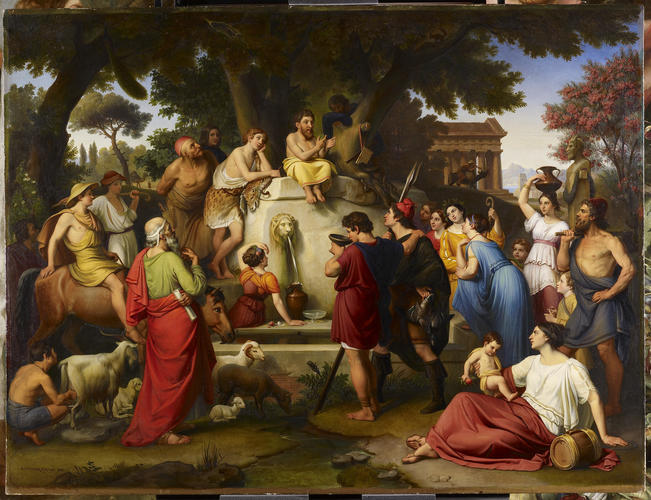Aesop Signed and dated 1855
Oil on canvas | 135.9 x 178.8 cm (support, canvas/panel/stretcher external) | RCIN 406331
-
Aesop sits on a rock in a sunlit glade, recounting his fables to a gathered crowd of listeners. Although little of certainty is known of Aesop’s life, according to tradition he was an enslaved person with physical deformities who was purchased in the marketplace at Samos by Xanthos, shown here as the well-dressed elderly man in the foreground holding a scroll bearing his name. The applicability of Aesop’s morals to everyone in society, irrespective of status, is indicated by the varied nature of the crowd, drawn from a broad cross-section of Greek society. The inclusion of many wild and domesticated animals alludes to the subject matter of Aesop’s works, but the artist has deliberately chosen to represent the creator rather than his creation.
As in Cimabue’s Madonna Carried in Procession (RCIN 410478) and Raphael’s First Sketch of the ‘Madonna della Sedia’ (RCIN 403635), the implication here is that great art is ingrained within the national psyche and can be understood and appreciated by all, regardless of education or status. This sympathetic portrayal of Aesop shows the great orator having risen above both his humble background and physical impediments – he is treated with the reverence of a king or saint. His intellect eventually won him his freedom: the red Phrygian cap worn by the man leaning on a spear is a symbol of liberty and republicanism.
Bavarian Johann Michael Wittmer (1802-1880) originally trained as a goldsmith before attending the Munich Academy. In 1826, Wittmer painted an altarpiece for a church in Isseldorf and helped with the execution of the fresco work then in progress at the Munich Glyptotek. In 1833, Wittmer accompanied Crown Prince Maximilian of Bavaria (1811-64) on a tour of Naples, Sicily, Corfu, Malta, Greece, Constantinople and Smyrna but it was Rome which had the most profound effect upon his work, the Nazarene painters whom he met there proving to be his dominant influence. In 1847 the Queen bought his painting Ossian (RCIN 406291) and presented it to Prince Albert on her birthday, 24th May, and in 1855 the Prince himself acquired this painting. These works, together with Wittmer's Raphael's First Sketch of the 'Madonna della Sedia' (mentioned above), were hanging at Osborne in 1876.
Text adapted from Portrait of the Artist, London, 2016Provenance
Purchased by Prince Albert in 1855; recorded at Osborne House, 1876
-
Creator(s)
Acquirer(s)
-
Medium and techniques
Oil on canvas
Measurements
135.9 x 178.8 cm (support, canvas/panel/stretcher external)
182.0 x 225.8 x 17.0 cm (frame, external)
Category
Object type(s)
Alternative title(s)
Aesop telling his fables









